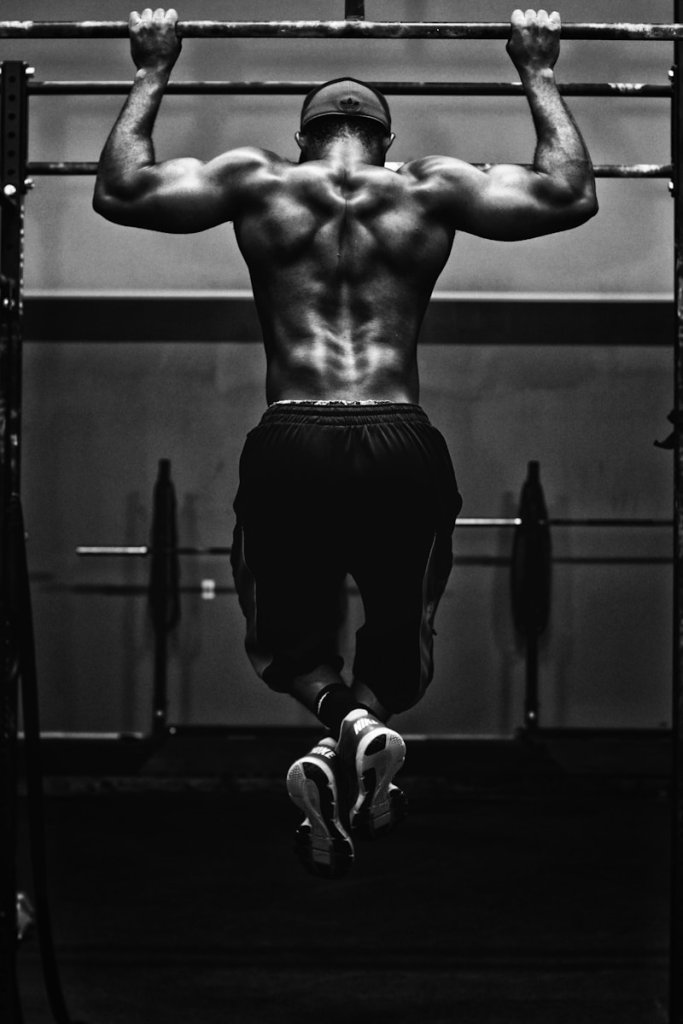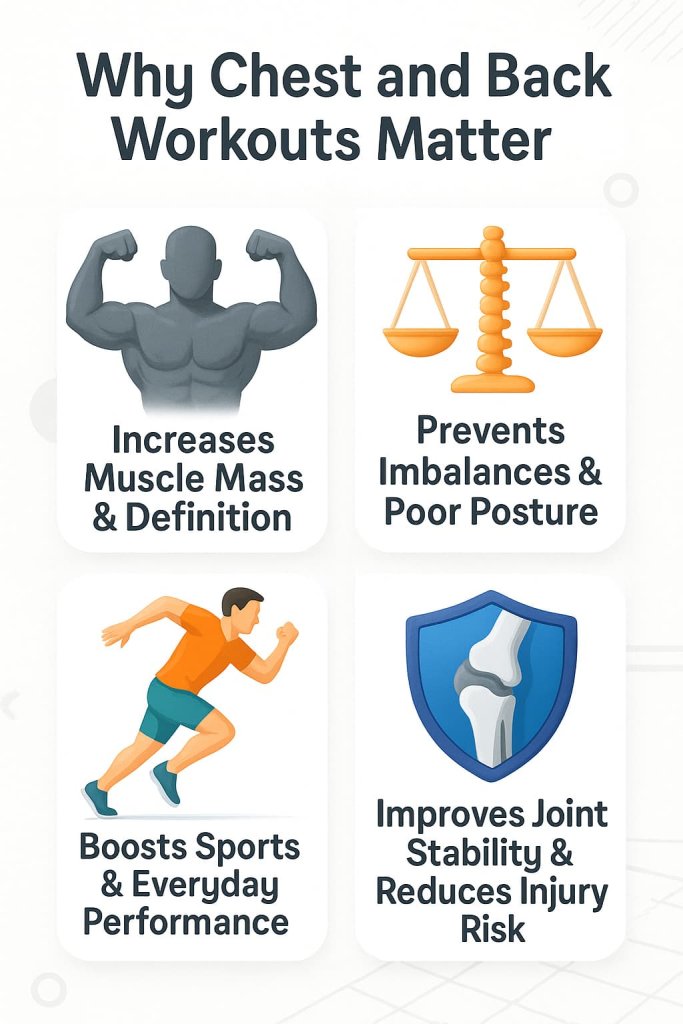If you want to build a powerful, well-balanced upper body, these are the best chest and back exercises, proven by both science and top trainers. Combining these moves delivers maximum muscle growth, strength, and posture benefits—no matter your experience level.

Understanding which chest and back exercises work best is crucial. Not only do these moves activate more muscle fibers, but they also protect your joints, improve posture, and prevent common injuries. This guide explains exactly which exercises to use, how to program them, and why they work, all based on the latest research and professional trainer input.
For official demonstrations and exercise guidance, visit the ACE Fitness Exercise Library.
Why Chest and Back Workouts Matter
The best chest and back workouts are essential for upper body strength, muscle balance, and injury prevention. These two muscle groups work together in every major movement—pushing, pulling, lifting, and stabilizing your spine and shoulders.

- Increases muscle mass and definition
- Prevents imbalances that lead to pain or poor posture
- Boosts sports performance and everyday function
- Improves joint stability and reduces injury risk
According to a 2023 EMG analysis (MDPI, 2023), combining push and pull exercises (like chest and back moves) in the same workout increases muscle growth and strength by up to 18% versus training them separately.
The 15 Best Chest and Back Exercises (Science-Backed)
The 15 best chest and back exercises are proven to maximize muscle growth, strength, and definition—confirmed by both exercise science and expert trainers. Whether you want a bigger chest, a broader back, or better posture, these exercises are your foundation.
Top Chest Exercises
1. Barbell Bench Press
Why It’s the Best:
The barbell bench press is the king of chest exercises, showing the highest pectoral activation in EMG research (MDPI, 2023). It works the entire chest, front deltoids, and triceps, making it a must for mass and strength.
How to Do It:
- Lie flat on a bench, feet planted.
- Grip the bar slightly wider than shoulder-width.
- Lower to mid-chest with control.
- Press up powerfully, keeping wrists straight.
Trainer Tips:
- Don’t bounce the bar off your chest—pause briefly.
- Pinch your shoulder blades together for stability.
- Spotter or safety arms recommended for heavy lifts.
Science Note:
Barbell bench press produces the highest mean and peak EMG readings for pec major and triceps among all chest presses (MDPI, 2023).
2. Incline Bench Press (Barbell or Dumbbell)
Why It’s Essential:
Incline bench press targets the upper chest (clavicular fibers) more than flat presses. A 30–45° angle activates the upper pecs, building a fuller chest.
How to Do It:
- Set bench to a 30–45° incline.
- Lower weights to the upper chest.
- Drive up with control.
Trainer Tips:
- Use a moderate incline—too steep shifts tension to shoulders.
- Control the negative (lowering) phase for muscle growth.
Science Note:
Incline angle increases upper pec activation versus flat or decline presses.
3. Decline Bench Press
Why It’s Effective:
Targets lower chest fibers and reduces shoulder strain for many lifters. Also allows heavier lifting for some.
How to Do It:
- Lie on a decline bench (15–30° down).
- Grip bar or dumbbells as for flat bench.
- Lower to lower chest, press up.
Trainer Tips:
- Always use a spotter or safety arms.
- Keep elbows at about 45° to your body.
4. Dumbbell Flyes (Flat or Incline)
Why Include It:
Dumbbell flyes deliver a deep stretch and a strong contraction in the chest. EMG studies show high pec activation, especially in the stretched position.
How to Do It:
- Lie on flat or incline bench, dumbbells over chest.
- Lower in a wide arc, slight bend in elbows.
- Feel the stretch, then bring dumbbells together.
Trainer Tips:
- Use lighter weights for joint safety.
- Stop before your arms go below bench level.
5. Push-Ups (Standard & Variations)
Why It’s a Staple:
Push-ups activate nearly as much chest muscle as bench presses (ACE, 2022), but with zero equipment. They’re excellent for beginners and advanced lifters alike.
How to Do It:
- Hands slightly wider than shoulders, body straight.
- Lower chest to floor, elbows at 45°.
- Press up strongly.
Best Variations:
- Incline/Decline Push-Ups
- Diamond Push-Ups
- Feet-Elevated Push-Ups
- Banded Push-Ups
6. Cable Chest Press / Crossover
Why Add It:
Cables provide constant tension—unlike free weights—and allow you to target any chest region by adjusting height. They’re joint-friendly and ideal for hypertrophy.
How to Do It:
- Set pulleys to desired height.
- Step forward, press handles together.
- Cross hands slightly for extra contraction.
Trainer Tips:
- Use moderate weight for control and safety.
- Squeeze chest at the end of the motion.
7. Dips (Chest-Focused)
Why Dips Work:
Chest-focused dips strongly activate the lower chest, triceps, and even shoulders. Leaning forward increases chest engagement.
How to Do It:
- Use parallel bars, lean slightly forward.
- Lower until elbows reach 90°, then push up.
- Keep chin tucked, elbows at 45°.
Trainer Tips:
- Go as low as comfortable (shoulders safe).
- Weighted dips for advanced progression.
Top Back Exercises
8. Pull-Ups / Chin-Ups
Why It’s the Best:
Pull-ups are the gold standard for upper back and lat development, with unmatched EMG activation (ACE, 2018).
How to Do It:
- Overhand grip (pull-up) = more upper lats.
- Underhand grip (chin-up) = more lower lats, biceps.
- Start dead hang, pull chin above bar.
Trainer Tips:
- Use full range of motion.
- Add weight as you get stronger.
9. Bent-Over Barbell Row
Why Rows Matter:
Rows build total back thickness—lats, mid-back, traps, and lower back. EMG data shows strong lat and trap recruitment.
How to Do It:
- Stand hip-width, hinge forward (flat back).
- Pull bar toward lower ribs, elbows close to body.
Trainer Tips:
- Don’t round your back—maintain a solid hinge.
- Squeeze shoulder blades at the top.
10. Seated Cable Row
Why Use It:
Seated cable rows allow you to focus on mid-back (rhomboids, traps) with less lower-back stress. Machine stability means better mind-muscle connection.
How to Do It:
- Sit tall, grab handles.
- Pull to torso, squeeze shoulder blades.
- Control return.
Trainer Tips:
- Keep chest up.
- Don’t use momentum.
11. Lat Pulldown
Who It’s For:
Lat pulldowns mimic the pull-up, but are adjustable for all strength levels. High lat and upper back activation, especially for those not yet able to do pull-ups.
How to Do It:
- Grip bar wider than shoulders.
- Pull to upper chest, elbows tucked.
- Control the negative.
Trainer Tips:
- Don’t swing—keep torso upright.
- Use varied grips for complete development.
12. Single-Arm Dumbbell Row
Why Single-Arm Rows?
They correct left-right muscle imbalances and build lat thickness, while challenging your core for stability.
How to Do It:
- One knee and hand on bench.
- Row dumbbell to hip, squeeze at the top.
Trainer Tips:
- Don’t twist your torso.
- Pause at the top for better contraction.
13. Inverted Row (Bodyweight Row)
Why Use It:
Great for scapular (shoulder blade) control, rear delts, and mid-back. Easy to progress by changing body angle.
How to Do It:
- Grip bar or suspension trainer, body straight.
- Pull chest to bar, squeeze shoulder blades.
Trainer Tips:
- Keep a rigid body line.
- Elevate feet to increase difficulty.
14. Straight-Arm Cable Pulldown
Why It’s Unique:
Isolates the lats and works them through a full stretch. Perfect as a pre-exhaust or finisher.
How to Do It:
- Stand tall, arms straight.
- Pull bar/rope to hips without bending elbows.
Trainer Tips:
- Use moderate/light weight.
- Feel the lats stretching and contracting.
15. Prone I-Y-T Raises
Why It’s Critical:
Targets lower traps, rotator cuff, and rear delts—vital for posture and shoulder health. Often neglected in classic programs.
How to Do It:
- Lie face down on bench (or stability ball).
- Raise arms to form an “I”, “Y”, and “T” shape.
Trainer Tips:
- Use very light weights.
- Focus on slow, controlled movements.
How to Structure Your Chest and Back Workout
Frequency: Train chest and back together 1–2 times per week, leaving at least 48 hours between sessions.
Sets/Reps:
- 3–4 sets of 8–12 reps (hypertrophy, muscle building)
- 2–4 sets of 4–8 reps (strength-focused moves)
- Warm up: 5–10 min light cardio, then dynamic stretches (e.g., arm circles, band pull-aparts)
Superset Example: Pair a chest and a back move for time efficiency and a great muscle pump:
- Bench Press + Pull-Up
- Dumbbell Fly + Bent-Over Row
- Incline Press + Seated Cable Row
- Push-Up + Inverted Row
Rest 60–90 seconds between sets or supersets. Focus on form, not just weight.
Trainer-Approved Sample Routines
Beginner Routine
| Exercise | Sets | Reps |
|---|---|---|
| Push-Ups | 3 | 10–15 |
| Inverted Rows | 3 | 8–12 |
| Incline Push-Ups | 2 | 12 |
| Single-Arm DB Row | 2 | 10 |
Intermediate Push-Pull Superset Routine
| Superset Pair | Sets | Reps |
|---|---|---|
| Bench Press + Pull-Up | 4 | 8–10 each |
| Incline DB Press + Row | 3 | 10–12 each |
| Cable Crossover + Seated Row | 3 | 12–15 each |
Home/Minimal Equipment Routine
| Exercise | Sets | Reps |
|---|---|---|
| Push-Ups | 4 | 12–20 |
| Inverted Row (table/bar) | 3 | 8–12 |
| Backpack Bent-Over Row | 3 | 12 |
| Resistance Band Fly | 3 | 15 |
Tip: Switch up your exercises and order every 4–6 weeks to keep making progress and avoid overuse injuries.
Tips for Progress, Safety, and Recovery
- Master form first: Quality reps beat heavy weights every time.
- Vary grip and angle: Use different grips and bench angles to target every muscle fiber.
- Use full range of motion: Go all the way down and up—don’t shortchange the movement.
- Warm up thoroughly: Loosen shoulders and activate upper back before heavy pressing or pulling.
- Recover well: Sleep 7–9 hours, eat protein with every meal, and take at least one full rest day weekly (CDC Sleep).
- Listen to your body: Pain is not gain—back off if you feel sharp discomfort or instability.
Frequently Asked Questions
Q: Should I train chest and back together or on separate days?
A: Both methods work. But research shows that combining push and pull exercises in one workout is time-efficient and helps balance muscle growth.
Q: Can I build my chest and back at home?
A: Absolutely! Push-ups, rows (using a table/bar), resistance bands, and backpack lifts provide enough variety for serious results.
Q: What if I can’t do pull-ups yet?
A: Start with lat pulldowns, assisted pull-ups, or inverted rows, and progress gradually.
Q: How do I avoid injury?
A: Prioritize perfect form, never “ego lift,” always warm up, and switch your grip or angle every few weeks.
Q: How fast will I see results?
A: Most people notice improved muscle tone and strength within 4–8 weeks of consistent, progressive training.
Conclusion
Maximize your upper body gains with these 15 science-backed chest and back exercises—each proven to deliver real results in muscle, strength, and posture. Whether you train in the gym or at home, consistent effort, progressive overload, and perfect form are your tickets to success.
Start now:
- Pick 3–4 chest and back moves from this list
- Program them into your weekly routine
- Track your progress and adjust every month
Need help with form? Check out the ACE Exercise Library or book a session with a certified trainer.
